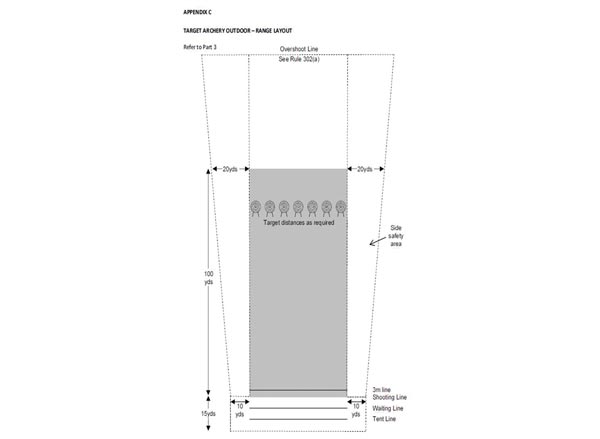Freddie Collier from Archery GB explains the essential rules and regulations you need to know when approaching the issue of safety at archery events

Diagram and rules can be found in Archery GB’s ‘Rules of Shooting’ document and are printed here with the kind permission of Archery GB
Q. I am an Archery GB level 2 coach, and recently a student on my beginners’ course asked the following question: Rule No.101 section b states, “Each member of Archery GB has a duty of care to ensure that his actions do not compromise the safety of himself or others.”
Who would be held responsible, at a shoot where the public are seated to the sides but in front of the shooting line, if there was an equipment failure and someone was injured, or worse, killed? Would it be the archer or the organisers?
A. The specifics of the question being asked are covered in Part 1 of the Archery GB Rules of Shooting, and Rules 101 and 102 have been reproduced below:
Bow Safety

101. Introduction
a) These bow safety rules apply to all archery disciplines. Other safety rules are given in the separate Parts of these Rules.
b) Each member of Archery GB has a duty of care to ensure that his actions do not compromise the safety of himself or others.
102. General
a) No archer may draw his bow, with or without an arrow, except when standing at the shooting line or peg. If an arrow is used, the archer shall aim toward the targets but only after being satisfied that the field is clear both in front of and behind the targets.
b) When drawing back the string of the bow an archer shall not use any technique which, in the opinion of the judges, could, if accidentally loosed, allow the arrow to fly beyond a safety zone or safety arrangements (overshoot area, net, wall, etc). If an archer persists in using such a technique, he will, in the interest of safety, be immediately asked by the Judge to stop shooting and to leave the area.
c) If anyone present where archery is taking place becomes aware that shooting should be halted for safety reasons, that person must call “FAST”. On hearing this call, all archers must immediately stop shooting, returning all unshot arrows to the quiver. If necessary, the call of “FAST” should be repeated by other archers to ensure that everyone has heard and stopped shooting. Shooting will recommence only on the instruction of the Judge.
d) The Judge, in consultation with the appointed tournament organiser is empowered to require any individual who is considered to be jeopardising the safety of the tournament to immediately leave the shooting ground.
The risk of injury due to equipment failure is mitigated generally by rule 102 and in particular, 102 (b). Archers using a “high” draw (overshoot risk) or “side” draw (or a combination of the two) would be employing techniques that a judge would not tolerate. It is unlikely that equipment failure during a normal “straight down the range” draw would result in an arrow straying outside of the side
safety area.
Clearly, the spectator side seating must be outside of the side safety area.
Provided the Archery GB Rules of Shooting are followed, accidents are highly unlikely. As long as Archery GB tournaments comply with the Archery GB Rules of Shooting, those tournaments (and the Archery GB members shooting at them) are covered by the Archery GB insurance policy.
World Archery

World Archery runs shoots that often host finals in venues laid out in a similar manner, and a World Archery spokesperson clarified their procedures, which apply to events such as World Cups and World Championships.
“We wouldn’t be able to give you a legal answer on responsibility that covers the world,” they said, “But can tell you that World Archery’s host city contracts, which are done on a case-by-case basis, cover issues of liability and responsibility with the organisers comprehensively.
“Our finals venues are subject to strict safety checks and the safety is maintained by having certain safety angles respected, which is also subject to matters such as the height of the first row of seating. Therefore, if these rules are respected, unless there is a deliberate action of the athlete, there is no safety issue.
“Our judges also check that the drawing of the bow is only in the direction of the targets and will immediately intervene if an athlete uses a drawing technique that is not compatible with this.”
This article originally appeared in the issue 112 of Bow International magazine. For more great content like this, subscribe today at our secure online store www.myfavouritemagazines.co.uk

